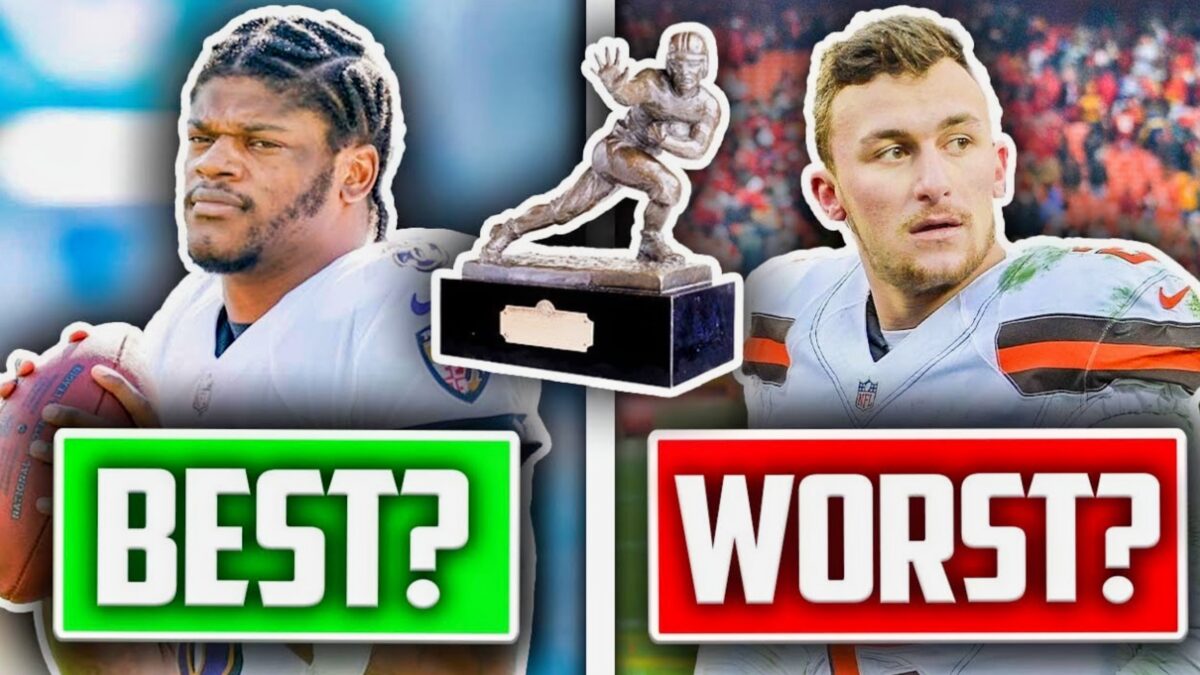
Winning the Heisman Trophy is such a thrilling and special honor in more ways than one. It’s obviously cool to be the best college football player in an entire nation, but also, winning the Heisman means you’re in great position for long-term NFL success.
While many Heisman Trophy winners have gone on to enjoy prolific careers in the pros, several others winners have reminded us that success in college doesn’t at all guarantee prospering in the NFL.
Here are the best Heisman Trophy winners since 2000 — and the 5 worst! — based entirely on how their NFL careers played out.
Best: Lamar Jackson
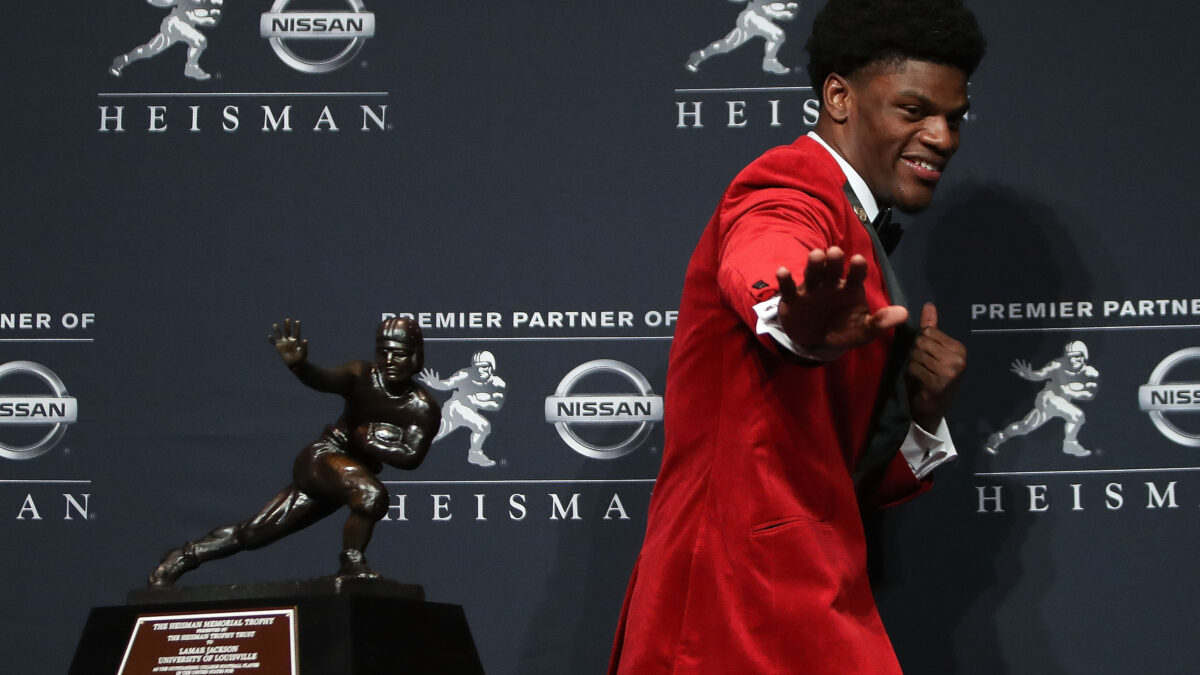
It’s absolutely comical to think that some NFL scouts suggested that Jackson make the switch from quarterback to wide receiver upon turning pro.
Jackson won the 2016 Heisman Trophy after throwing for 30 touchdowns to go along with 1,571 rushing yards and a whopping 21 rushing touchdowns. Jackson also took home the Maxwell and Walter Camp Awards in his Heisman Trophy-winning season.
The Baltimore Ravens traded up via the Philadelphia Eagles so they could take Jackson 32nd overall in 2018. Fast forward a few years later, and we continue to laugh at the suggestion that he switch to receiver.
Click on ‘Follow Us’ and get notified of the most viral NFL stories via Google! Follow Us
Jackson won six of seven starts in his rookie year and led the Ravens to the AFC North division title. A year later, he won the MVP award after tossing a league-leading 36 touchdowns and rushing for 1,206 yards – the most ever by a QB in a single season. Jackson led the Ravens to the postseason again in 2020 and would have gotten them there again in 2021 if he didn’t miss the final four games to injury.
The Ravens went from mediocrity to long-term title contender under Jackson. At full strength, the rush-heavy Baltimore offense has been nearly impossible to stop. Jackson is one of the game’s most dynamic quarterbacks, and he’s going to be a joy to watch for plenty more ears to come.
Worst: Johnny Manziel
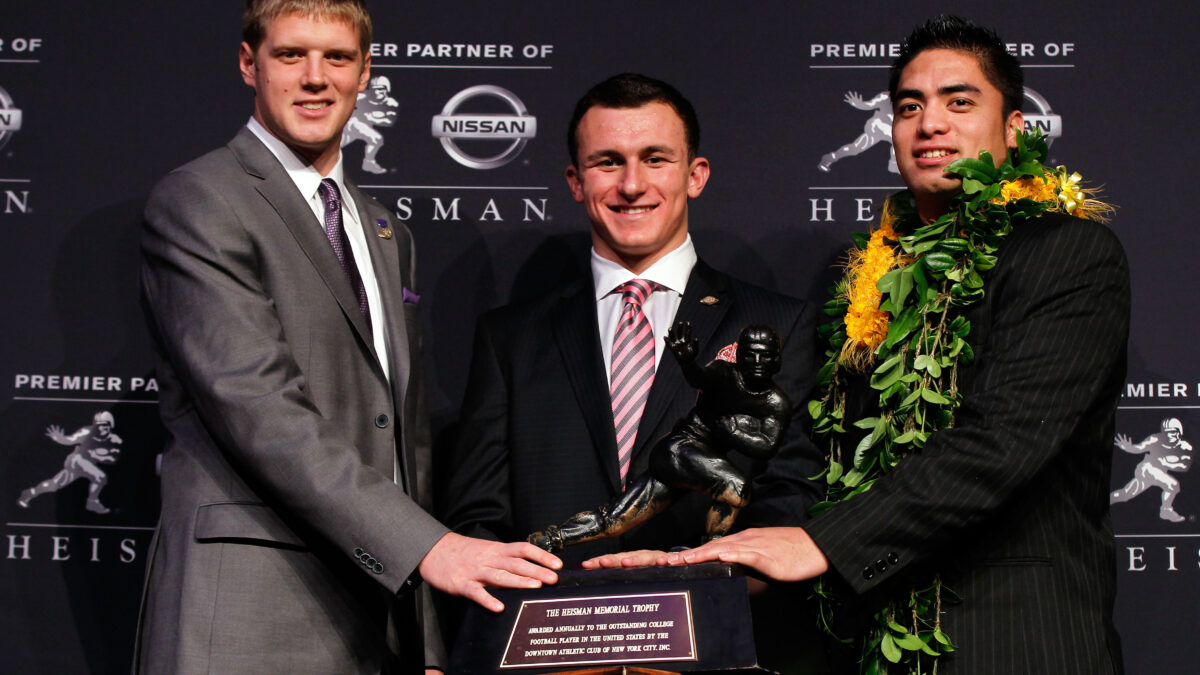
“Johnny Football” dazzled in his first season at Texas A&M in 2012. He tossed 3,706 passing yards and 26 touchdowns to go with 1,410 rushing yards and 21 rushing touchdowns.
Manziel had another strong season in 2013, earning a second straight First-team All-SEC nod.
There were questions about if Manziel’s style of play would translate successfully over to the NFL level. Questions about his character and attitude were also frequent. He was considered the ultimate boom-or-bust prospect heading into the 2014 Draft.
The Cleveland Browns drafted Manziel 22nd overall in 2014, but they soon learned that this was not going to be the version of “Johnny Football” they saw at Texas A&M.
Manziel had several off-the-field issues during his two seasons with Cleveland. He was often seen partying hard out in public when he should’ve been practicing and studying game film. He even reportedly slept off hangovers at the team’s facility.
Manziel wound up starting just eight games for the Browns. He lost 6 of 8 games and threw seven touchdowns against as many interceptions. The Browns released Johnny Football after two seasons, and he was never given another opportunity in the NFL again.
Best: Derrick Henry
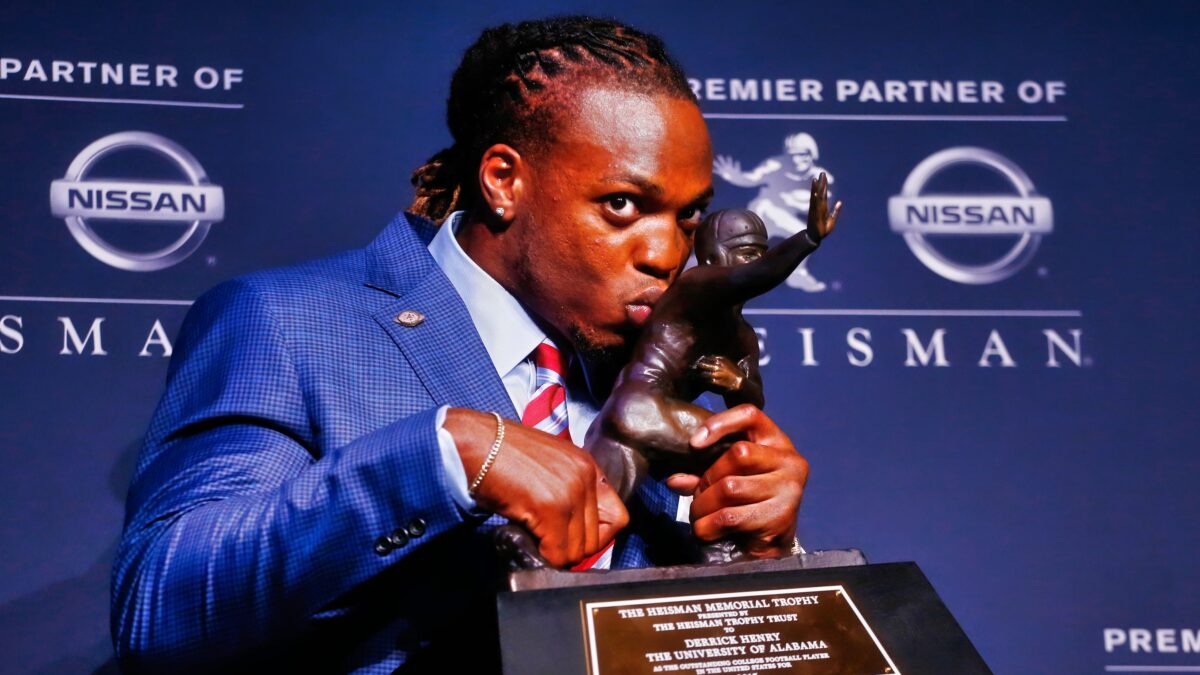
We’ve seen countless star running backs come out of Alabama, but the 2015 version of Derrick Henry was truly a sight to behold.
Henry rushed for 2,219 yards and 28 rushing touchdowns in the 2015 season en route to Heisman Trophy honors. The Crimson Tide went on to defeat the Clemson Tigers in the National Championship Game.
The Tennessee Titans drafted Henry in the second round – 45th overall – in 2016. The 6-foot-3, 247-pound bulldozer has been football’s No. 1 running back since 2018, winning back-to-back rushing titles in the 2019 and 2020 seasons.
Henry had 33 total rushing touchdowns over those two years. He led the Titans to a surprise 2019 AFC Championship Game appearance and won 2020 Offensive Player of the Year honors after becoming the eighth player to rush for 2,000 yards in a season.
Henry is truly in his own class of NFL running backs. He probably would’ve won a third straight rushing title in 2021 if he didn’t miss nine games, too.
Because running backs wear down so quickly these days, it’s hard for them to make a Hall of Fame case. But we have little doubt that Henry is going to get there one day when all is said and done.
Worst: Troy Smith
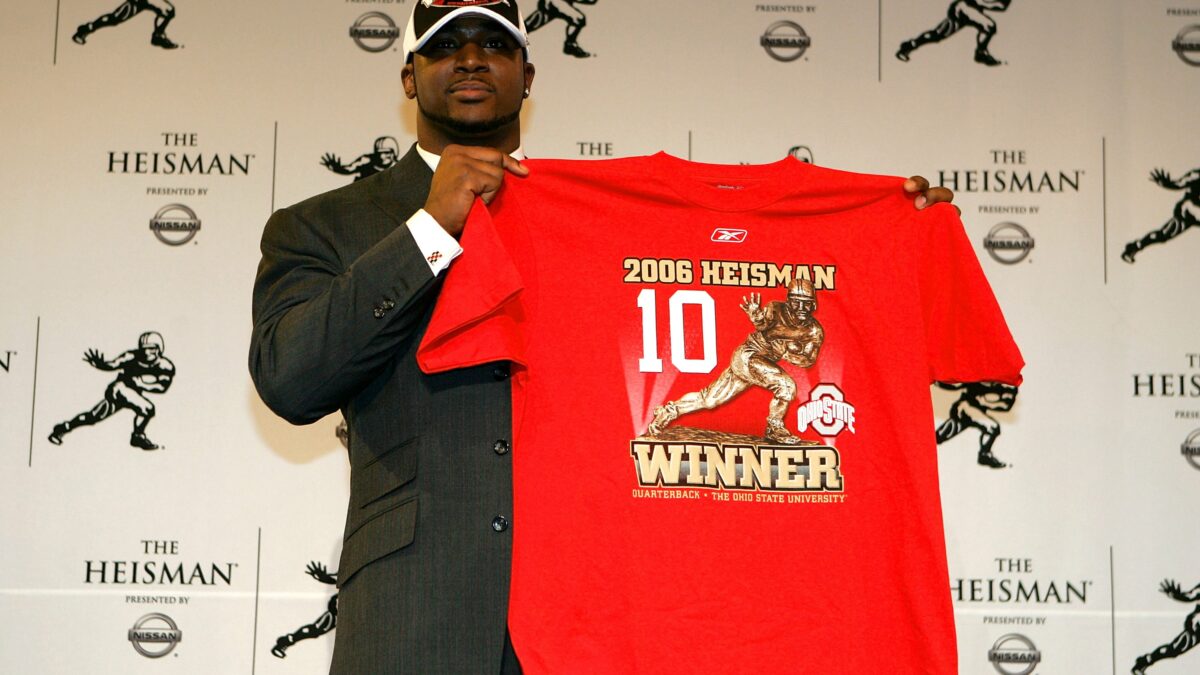
If you kids haven’t heard of Troy Smith, that’s okay. His NFL career was awfully short-lived, and he wasn’t even a hyped-up prospect when he entered the 2007 draft.
Smith won the 2006 Heisman Trophy at Ohio State after completing 65.3 percent of his pass attempts for 2,542 yards and 30 touchdowns against six interceptions. But there were significant concerns about Smith’s size —- 6 feet in height — for starters.
Not only that, but the likes of JaMarcus Russell, Brady Quinn and Kevin Kolb (COBB) were just a handful of the many quarterbacks that scouts loved over Smith. Of course, none of these guys really panned out at the NFL level.
The Ravens drafted Smith in the fifth round — 174th overall — to serve as a third-stringer behind Steve McNair and Kyle Boller. Smith made two starts in his rookie year and saw four game appearances, tossing 452 yards and two touchdowns against zero interceptions.
Smith would attempt just 13 total passes over the next two seasons in Baltimore as a backup to Joe Flacco, the Ravens’ 2008 first-round pick. He got the chance to revive his career with the San Francisco 49ers in 2010, making six starts but hardly impressing with a 50.3 completion percentage with five touchdowns against four picks.
That would be it for Smith at the NFL level.
Best: Carson Palmer
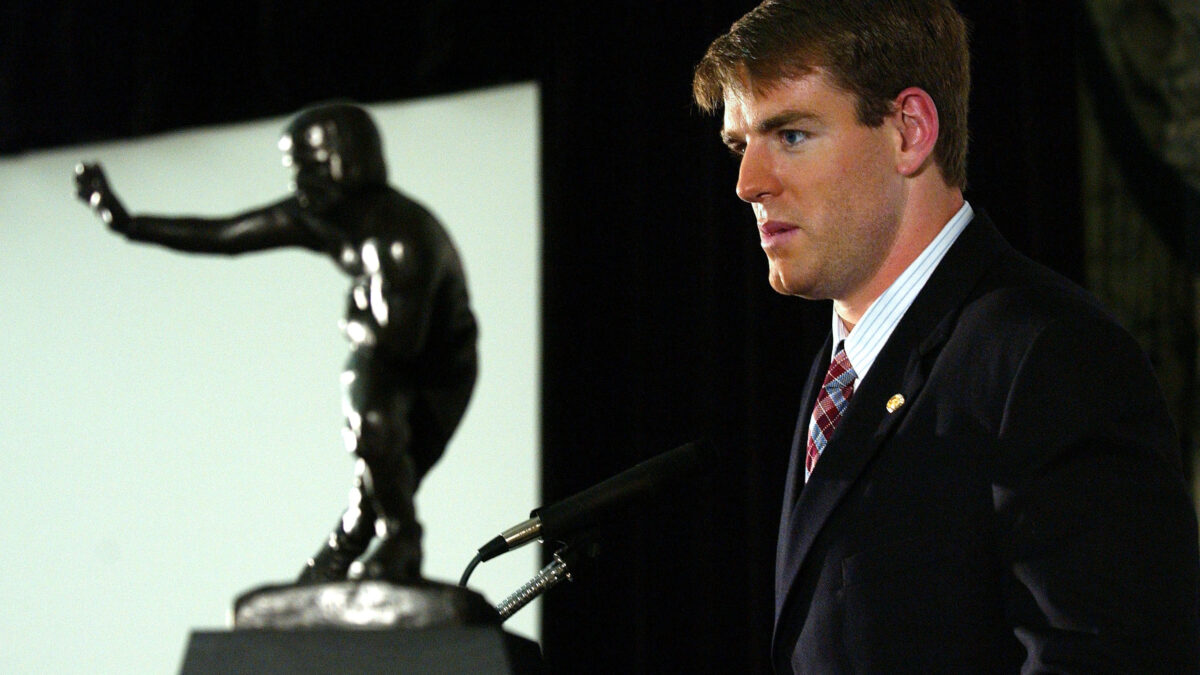
Palmer will go down as one of the better quarterbacks kept out of the Pro Football Hall of Fame. He lived up to expectations for the most part, but if it weren’t for injuries and brutal mismanagement by the Cincinnati Bengals during his prime years, who knows how much better his career could’ve played out?
Anywho, as far as Heisman Trophy winners who make it to the NFL go, Palmer did pretty good. He won the honors in 2002 — his final season at USC — after throwing for 3,942 yards and 33 touchdowns against 10 picks.
The Bengals drafted Palmer first overall in 2003, but then-Cincy head coach Marvin Lewis decided not to play the rookie at all in his first season. After an up-and-down rookie year, Palmer broke out in 2005 by tossing a league-leading 32 touchdowns – helping Cincy to the AFC North division crown.
Palmer also led Cincinnati to the division title again in 2009, but clashes with the front office and coaching staff led to his departure in 2011. He was traded to the Oakland Raiders midseason but had a disastrous two-year tenure there.
The 3-time Pro Bowler enjoyed a career revival under Bruce Arians with the Arizona Cardinals. Palmer led the Redbirds to three winning seasons and the 2015 NFC Championship Game, where they fell to the Carolina Panthers.
Palmer retired with 46,247 passing yards and 294 touchdowns.
Worst: Chris Weinke
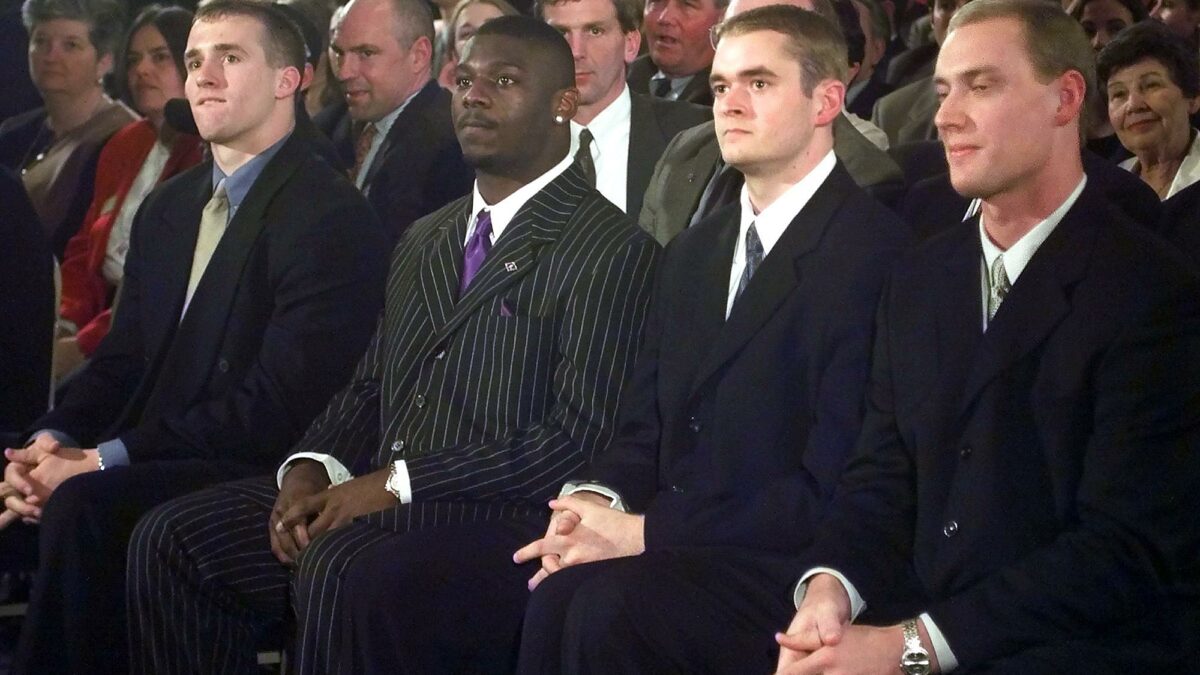
If Weinke wasn’t so good at multiple sports, perhaps he would’ve had a stellar NFL career.
Weinke starred at football, baseball and ice hockey during his youth years. The Toronto Blue Jays drafted Weinke in 1990, and he initially decided to pursue a professional baseball career.
Weinke initially had a change of heart and joined Florida State in 1997, when he was already 25 years of age. In 2000, his age-28 season, Weinke won the Heisman after throwing for 4,167 passing yards and 33 touchdowns against 11 picks.
The Carolina Panthers drafted Weinke in round four — 106th overall – in 2001. So the dude was already 29 years of age by the time he turned pro. It was quite the disadvantage, alright.
Weinke was Carolina’s main starter in his rookie year, but he lost 14 of 15 starts and had just 11 touchdowns against 19 picks. He remained with the organization until 2006, making just four total starts over his final five years there.
Weinke joined the 49ers in 2007, making one start and appearing in just two games altogether. He was out of the league for good after the ‘07 season, finishing his NFL career with a 2-and-18 record, a 54.4 completion percentage and 15 touchdowns against 26 interceptions.
Best: Cam Newton
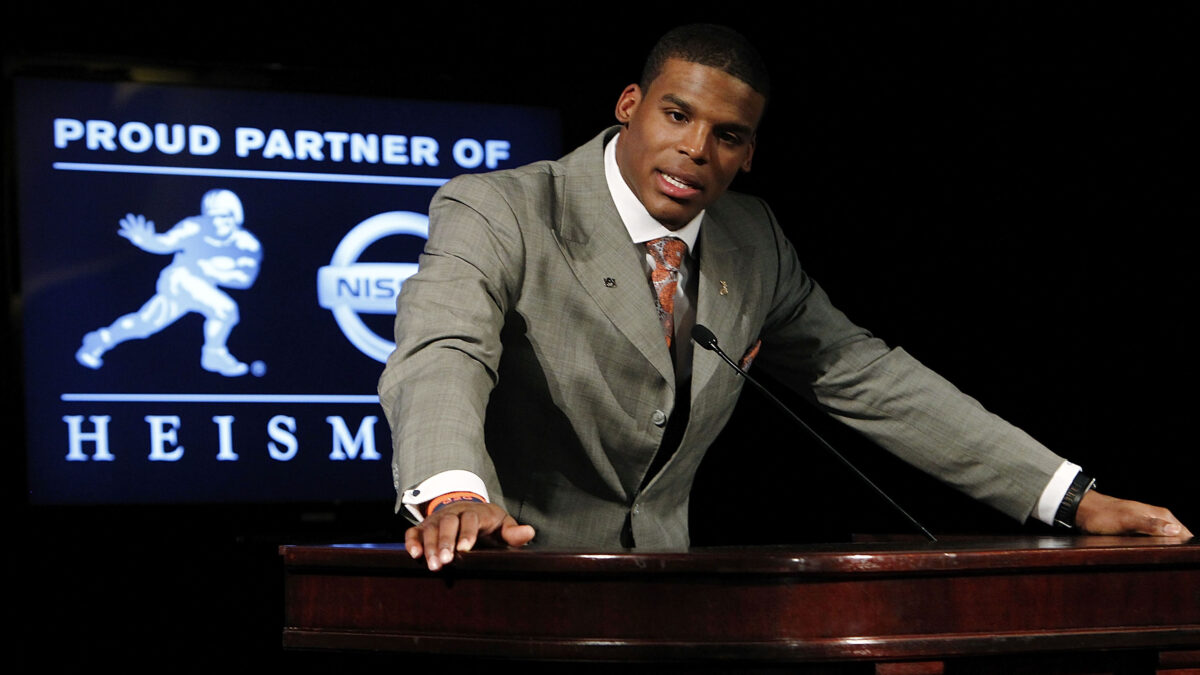
“Super Cam” had one of the best seasons in NCAA history back in 2010. He led the Auburn Tigers to a national championship and claimed the Heisman Trophy, finishing the year with 2,854 passing yards, 30 touchdowns and 1,473 rushing yards and 20 rushing scores.
The QB-needy Panthers selected Newton first overall in the dream 2011 NFL Draft — and the move was a franchise-changer alright.
Newton spent his first nine seasons with Carolina, leading them to three straight NFC South division titles from 2013 to 2015 plus a wild card berth in 2017. The three-time Pro Bowler won the 2015 league MVP, leading Carolina to a Super Bowl 50 appearance.
Unfortunately, injuries derailed Newton’s final seasons with the Panthers – leading to his release in 2019. A one-year stint with the New England Patriots in 2020 didn’t amount to much, and a return to Carolina in 2021 didn’t yield any special results.
Still, Newton supplied Carolina with the best QB in franchise history. After spending several years in mediocrity, he turned them into a consistent playoff contender over a five-year stretch — getting them awfully close to their first Super Bowl championship as well.
Totally worth the first overall pick if you ask us!
Worst: Sam Bradford
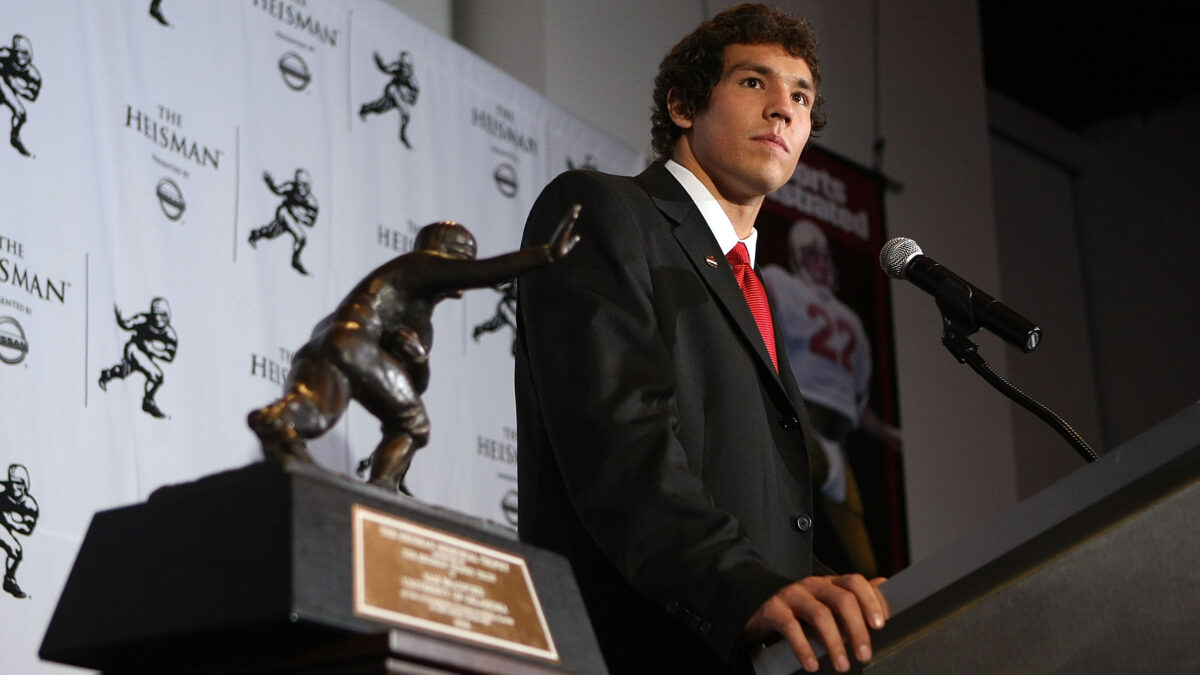
Bradford wasn’t exactly terrible in the NFL. He had his moments and all. It’s just a shame that injuries derailed his career. At the same time, when he was healthy, his production didn’t warrant that of a first overall selection.
The Oklahoma product pieced together one of the greatest NCAA seasons EVER back in 2008. Bradford threw for 4,720 yards and 50 touchdowns en route to the Heisman honors.
A shoulder injury sidelined Bradford for all but three games in his swan song 2009 NCAA season. But his 2008 season was all the St. Louis Rams needed to see, and Bradford went first overall in the 2010 draft.
Bradford won 2010 Offensive Rookie of the Year honors, but that would unfortunately be his peak with the Rams. He missed six games in 2011 and suffered a season-ending ACL tear in 2013 after playing seven games. Bradford tore the same ACL in a preseason game and missed all of 2014.
Bradford was later sent to the Philadelphia Eagles in a blockbuster trade that brought Nick Foles over to the Rams. Bradford had an up-and-down season there and was traded to the Minnesota Vikings in 2016 after they lost starting QB Teddy Bridgewater for the year.
Bradford fared pretty well in Minnesota but lost his starting job to Case Keenum after suffering a knee injury, and Keenum never lost it. Bradford signed with the Arizona Cardinals in 2018 but lost his starting duties to rookie Josh Rosen, and the former was out of the NFL for good soon after.
Best: Joe Burrow
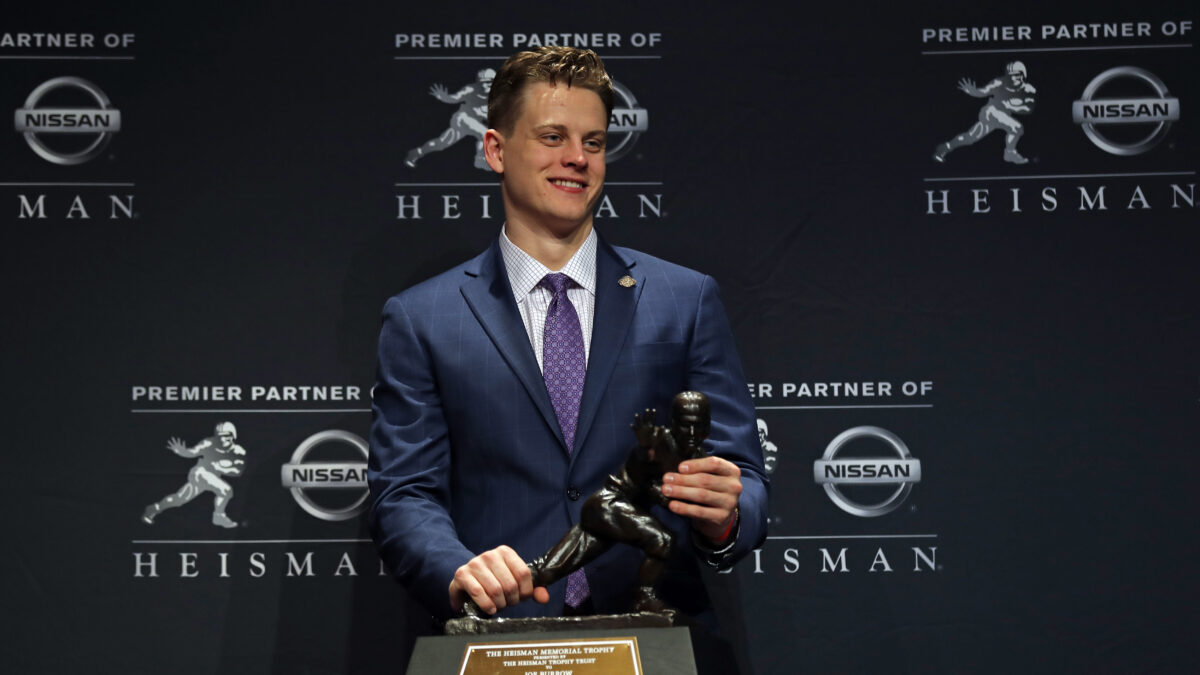
Burrow’s 2019 season with the LSU Tigers was, quite simply, the best in NCAA history. Plain and simple.
All he did was complete 76.3 percent of pass attempts for 5,671 yards and 60 (!) touchdowns against six interceptions. Burrow added 368 rushing yards and five rushing scores to win the Heisman Trophy. He put the final cherry on top by leading the Tigers to a blowout victory over Trevor Lawrence’s Clemson Tigers in the National Championship Game.
The Bengals drafted Burrow first overall in 2020, and the rest, as they say, is history. His rookie season was cut short with an ACL and MCL tear. He returned to full strength in 2021 and won Comeback Player of the Year honors, leading the Bengals to a surprise Super Bowl 56 appearance.
They narrowly lost to the Los Angeles Rams in the big dance, but it was a thrilling and highly successful season nonetheless. Burrow has easily met the sky-high expectations coming into the league as a former Heisman Trophy winner. It’s not too early to project multiple MVP awards and Super Bowl championships in his future…
Worst: Matt Leinart
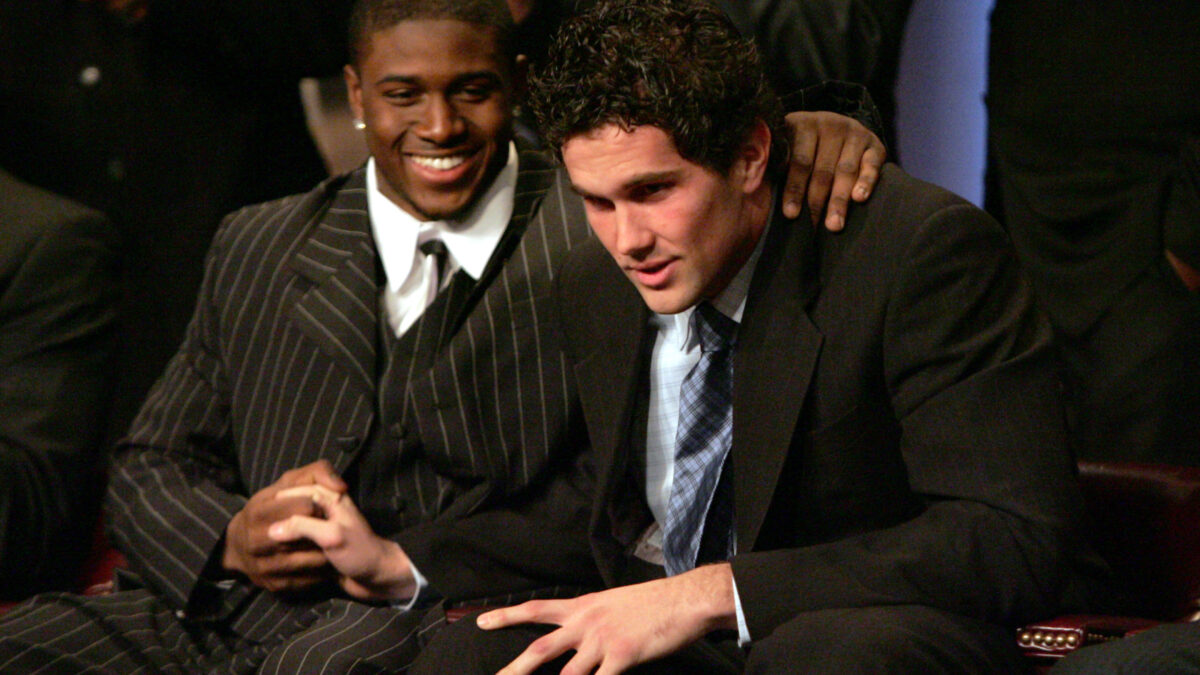
Leinart was a star for the Pete Carroll-led USC Trojans. It was hard to watch him in college and NOT believe that he simply had future NFL stardom written all over him.
In 2004, Leinart won the Heisman after throwing for 3,322 yards and 33 touchdowns against six interceptions. The Trojans went on to win the national championship, though it was later vacated because of the Reggie Bush-improper-benefits scandal.
Leinart and the Trojans went back to the Rose Bowl in 2005, but they lost a classic to the Vince Young-led Texas Longhorns in the waning seconds. With a successful college career in the books, it was time for Leinart to take his talents to the professional level.
Leinart was taken 10th overall by the Cardinals in 2006. But injuries and a career resurgence from former MVP Kurt Warner prevented Leinart from ever getting a real shot in Arizona, and he was released in 2010.
Leinart joined the Houston Texans in 2011 and became the starter after Matt Schaub suffered a season-ending foot injury. Unfortunately, Leinart fractured his collarbone and was done for the year – prompting Houston to roll with third-stringer TJ Yates.
Leinart saw a bit of playing time for the Raiders in 2012 but was ultimately released. He was out of the NFL soon after, becoming one of the biggest “what if” stories of his era.


